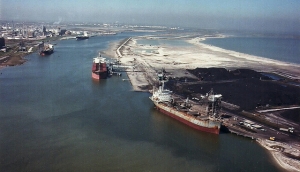
The state of Texas has financed a little more than $300 million in port improvements since 2010. That’s not much when compared to the $46 billion that port officials from both the public and private sectors nationwide say is needed because of the Panama Canal expansion. That jaw-dropping total may even increase because port officials throughout the country are still inventorying multi-million-dollar project needs that will be required.

Photo of Corpus Christi shipping channel by Jay Phagan licensed under CC BY 2.0.
The Texas Senate is about to get involved. Noting that several Texas ports are among the busiest and most productive in the United States for import and export, and recognizing the significant economic impact ports have on the state’s economy, Texas’ lieutenant governor appointed seven members of the Senate to a newly created committee that will focus specifically on Texas ports.
The new Senate select committee will study the economic benefits the canal expansion will have on the state’s ports and make recommendations. Members all represent an area of Texas where a port or an industrial airport designed for cargo is located.
At least 20 percent of the nation’s port tonnage travels through Texas ports. That is significant and port officials have been on alert and making plans for more than a year. Texas ports generate approximately $5 billion in local and state tax revenue and more than $9 billion in federal import tax revenue each year. And nearly 1.4 million jobs are generated by port activity. The jobs alone represent $828 billion in personal income.
The economic impact to Texas is huge. An immediate, concentrated focus on every aspect of the state’s ports, including all inland ports in Texas, is certainly justified. Keeping these ports competitive is critically important to all Texans.
Three Texas ports – Houston, Corpus Christi and Beaumont – are among the 10 most utilized ports in the nation. The Panama Canal project was initiated to let larger vessels, sometimes called megaships, pass through the canal and travel to America. Shipping channels that can accommodate the vessels will see increased trade. Ports that cannot accommodate the larger ships will not remain competitive. As a result, almost all ports have plans to launch projects to deepen their harbors and construct larger terminals. The Port of Houston approved and announced a 2016 capital improvement program that calls for $314 million in spending.
Trade in recent years has been hindered by the need for expansion of the Panama Canal. The two-lock canal restricted both the size and number of ships that were able pass through it. Work on the current expansion plan began in 2007 and was expected to double the capacity of the canal. New locks were part of the project, as were the widening and deepening of the channels and excavating new channels to access the locks.
The United States was listed among the countries that would most benefit from the expansion. That projection, however, was based on the assumption that U.S. ports would make the necessary port improvements. The clock is ticking and hundreds of infrastructure projects must be completed in the very near future. Firms that provide dredging, construction, engineering, architecture, security, etc. will find an abundance of contracting opportunities at the ports in Texas. The state hopes to be ready for the megaships and the economic potential afforded by Texas ports.
SPI’s team of government consulting experts can help you navigate the world of selling to government. Contact them today!
